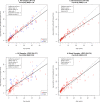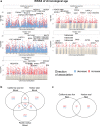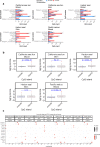Multi-tissue DNA methylation aging clocks for sea lions, walruses and seals
- PMID: 37005462
- PMCID: PMC10067968
- DOI: 10.1038/s42003-023-04734-0
Multi-tissue DNA methylation aging clocks for sea lions, walruses and seals
Abstract
Age determination of wild animals, including pinnipeds, is critical for accurate population assessment and management. For most pinnipeds, current age estimation methodologies utilize tooth or bone sectioning which makes antemortem estimations problematic. We leveraged recent advances in the development of epigenetic age estimators (epigenetic clocks) to develop highly accurate pinniped epigenetic clocks. For clock development, we applied the mammalian methylation array to profile 37,492 cytosine-guanine sites (CpGs) across highly conserved stretches of DNA in blood and skin samples (n = 171) from primarily three pinniped species representing the three phylogenetic families: Otariidae, Phocidae and Odobenidae. We built an elastic net model with Leave-One-Out-Cross Validation (LOOCV) and one with a Leave-One-Species-Out-Cross-Validation (LOSOCV). After identifying the top 30 CpGs, the LOOCV produced a highly correlated (r = 0.95) and accurate (median absolute error = 1.7 years) age estimation clock. The LOSOCV elastic net results indicated that blood and skin clock (r = 0.84) and blood (r = 0.88) pinniped clocks could predict age of animals from pinniped species not used for clock development to within 3.6 and 4.4 years, respectively. These epigenetic clocks provide an improved and relatively non-invasive tool to determine age in skin or blood samples from all pinniped species.
© 2023. The Author(s).
Conflict of interest statement
S.H. is a founder of the non-profit Epigenetic Clock Development Foundation, which plans to license several of his patents from his employer UC Regents. The other authors declare no conflicts of interest.
Figures





Similar articles
-
The Ancestral Carnivore Karyotype As Substantiated by Comparative Chromosome Painting of Three Pinnipeds, the Walrus, the Steller Sea Lion and the Baikal Seal (Pinnipedia, Carnivora).PLoS One. 2016 Jan 28;11(1):e0147647. doi: 10.1371/journal.pone.0147647. eCollection 2016. PLoS One. 2016. PMID: 26821159 Free PMC article.
-
Use of spectral analysis to test hypotheses on the origin of pinnipeds.Mol Biol Evol. 1995 Jan;12(1):28-52. doi: 10.1093/oxfordjournals.molbev.a040189. Mol Biol Evol. 1995. PMID: 7877495
-
Predictive equations for the estimation of body size in seals and sea lions (Carnivora: Pinnipedia).J Anat. 2014 Aug;225(2):232-45. doi: 10.1111/joa.12199. Epub 2014 Jun 10. J Anat. 2014. PMID: 24916814 Free PMC article.
-
Hydrodynamic perception in true seals (Phocidae) and eared seals (Otariidae).J Comp Physiol A Neuroethol Sens Neural Behav Physiol. 2013 Jun;199(6):421-40. doi: 10.1007/s00359-012-0778-2. Epub 2012 Nov 24. J Comp Physiol A Neuroethol Sens Neural Behav Physiol. 2013. PMID: 23180048 Review.
-
Vocal learning in seals, sea lions, and walruses.Curr Opin Neurobiol. 2014 Oct;28:66-71. doi: 10.1016/j.conb.2014.06.011. Epub 2014 Jul 18. Curr Opin Neurobiol. 2014. PMID: 25042930 Review.
Cited by
-
Extreme longevity may be the rule not the exception in Balaenid whales.Sci Adv. 2024 Dec 20;10(51):eadq3086. doi: 10.1126/sciadv.adq3086. Epub 2024 Dec 20. Sci Adv. 2024. PMID: 39705342 Free PMC article.
-
Epigenetic Clock in Bears: A Simple Cost-Effective Blood DNA Methylation-Based Age Estimation Method Applicable to Multiple Bear Species.Ecol Evol. 2025 May 6;15(5):e71424. doi: 10.1002/ece3.71424. eCollection 2025 May. Ecol Evol. 2025. PMID: 40330099 Free PMC article.
-
The androgen clock is an epigenetic predictor of long-term male hormone exposure.Proc Natl Acad Sci U S A. 2025 Jan 21;122(3):e2420087121. doi: 10.1073/pnas.2420087121. Epub 2025 Jan 13. Proc Natl Acad Sci U S A. 2025. PMID: 39805019 Free PMC article.
-
Estimating Polar Bear (Ursus maritimus) Age Based on an Epigenetic DNA Methylation Clock.Ecol Evol. 2025 Jul 28;15(8):e71870. doi: 10.1002/ece3.71870. eCollection 2025 Aug. Ecol Evol. 2025. PMID: 40740792 Free PMC article.
-
DNA methylation-based age prediction and sex-specific epigenetic aging in a lizard with female-biased longevity.Sci Adv. 2025 Jan 31;11(5):eadq3589. doi: 10.1126/sciadv.adq3589. Epub 2025 Jan 31. Sci Adv. 2025. PMID: 39888991 Free PMC article.
References
-
- Garlich-Miller J, Stewart R, Stewart B, Hiltz E. Comparison of mandibular with cemental growth-layer counts for ageing Atlantic walrus (Odobenus rosmarus rosmarus) Can. J. Zool. 1993;71:163–167. doi: 10.1139/z93-022. - DOI
-
- Richard P, Campbell R. Status of the Atlantic walrus, Odobenus rosmarus rosmarus, in Canada. Can. Field Naturalist. 1988;102:337–350.
-
- Previdi M, Smith KL, Polvani LM. Arctic amplification of climate change: a review of underlying mechanisms. Environ. Res. Lett. 2021;16:093003. doi: 10.1088/1748-9326/ac1c29. - DOI
-
- Gulland, F. M. et al. A review of climate change effects on marine mammals in United States waters: past predictions, observed impacts, current research and conservation imperatives. Clim. Chang. Ecol.3, 100054 (2022).
Publication types
MeSH terms
LinkOut - more resources
Full Text Sources
Molecular Biology Databases

